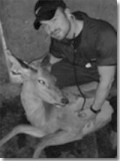René Garcia, DVM
Staff Veterinarian/ Imaging Intern
Dr. René Garcia joined our practice earlier this year as our staff veterinarian and imaging intern, making him in charge of all of our I-131 therapy feline patients. He is the doctor veterinarians and owners discuss cases with, and he helps to oversee all of the the pretreatment imaging, treatment, and hospitalization. We are very happy to have such a talented young man join our practice for a one-year stay with us, and we thoroughly enjoy hearing about his professional and life experiences that he brings with him from all over the world.
Here is Dr. Garcia’s story…
Growing up in South Miami, across the street from the Everglades, wildlife conservation and reptiles were always a big part of my life. After a brief career as a firefighter and EMT, I decided that my desire to be a veterinarian and travel the world were too strong for me to continue a stationary, lifelong career with the fire department. My career goal to become a veterinarian led me on the journey of a lifetime, to one of the most respected veterinary schools in the world at Massey University, in Palmerston North, New Zealand. After seven years of living abroad, experiencing different cultures, making friends all over the world, all while focusing on becoming the best veterinarian I can be, I returned to America to start a mobile veterinary hospital that services Los Angeles and Ventura counties.
Q. What is your life outside of VICSD like?
A. My life revolves around my best friend and buddy, Mako, a 7-year-old MN New Zealand Huntaway that was taken directly from the rugged, chilly, steep sheep country of central New Zealand, to the soft, warm, and pillowtop confines of his Sunset Cliffs home.
Q. We love Mako! What else are you passionate about in life?
An avid traveler, I have visited an average of three different countries a year for the past seven years. International travel has gone from being a hobby to a lifestyle. The next planned vacation is… six nights in Iceland in early spring, 2012! Two of those nights will be spent dogsledding, led by the strong Greenlandic dog team, while enjoying the wild and untouched Icelandic countryside!
Q. Which imaging modality have you most enjoyed learning about?
A. The advances in advanced imaging modalities over the past few years have been a fascinating trend to follow. And while the technology and quality of these amazing imaging modalities has improved exponentially, so has their affordability to the consumer. We can now perform a full CT scan of the thorax to more accurately look for pulmonary metastasis, or scan the abdomen for surgical planning for just a little more than 3 view radiographs of the same structures would cost the client. And as time passes, I expect the trend to move from traditional imaging practices to more advanced imaging modalities, just as the human field has done over the past decade. With all these tools and diagnostic capabilities at our fingertips, this is an exciting time to be a veterinarian!
Q. Is there a unique case where CT was used that really stands out in your mind?
A. One case that stands out to me was an older MN Labrador, with a history of thoracolumbar pain, elevated ALT, ALP, and cholesterol, with alopecia and a distended abdomen. Abdominal radiographs were unremarkable other than a mild hepatomegaly. Abdominal ultrasound revealed a diffusley hyperechoic liver, and a large right adrenal mass was identified, but it was not certain whether this adrenal tumor was invading the surrounding vasculature. After a CT with contrast was performed, accurate intraluminal invasion of the phrenicoabdominal vein and caudal vena cava was detected accurately. Surprisingly, local invasion into the epaxial and hypaxial musculature was also identified, helping explain the dog’s back pain in the absence of intervertebral disk disease.





